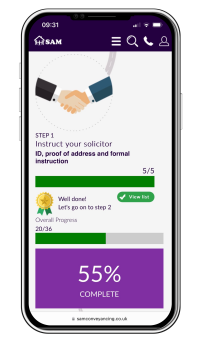Stamp Duty is paid at different rates, depending on the purchase price and if you own more than one property (read more about the second home stamp duty charge below).
You should call HMRC for help with Stamp Duty Land Tax queries and to confirm your own personal liability on 0300 200 3510 Opening times: 8.30 am to 5 pm, Monday to Friday (closed weekends).
| Property Price | Standard Rate of Stamp Duty | Additional Home Rate (updated post Oct 2024 budget) | Non UK Resident Rate |
| £0 - £125,000 | 0% | 5% | 2% |
| £125,001 - £250,000 | 2% | 5% | 2% |
| £250,001 - £925,000 | 5% | 10% | 2% |
| £925,001 - £1.5 million | 10% | 15% | 2% |
| Over £1.5 million | 12% | 17% | 2% |

Fixed quote for our legal costs plus a budget-friendly breakdown of third-party disbursements.

Your sale or purchase is protected by our no sale, no fee guarantee.

Our panel solicitors are pre-approved to work with 99% of mortgage lenders in England & Wales.

Panel solicitors accredited by the Conveyancing Quality Scheme; regulated by the SRA.
What is stamp duty?
Stamp duty land tax is payable when you buy land or property over a certain price. You can use the above stamp duty calculator to work out your liability using the current tax band rates.
The process for paying your stamp duty is easy for buyers because your solicitor will normally do this for you. After completion, the solicitor files a Stamp Duty Land Tax (SDLT) Form with the HM Revenue & Customs online (although some can still submit a paper submission). Even if there is no stamp duty liability, the solicitor is still required to file a tax return.
Any stamp duty payable must be paid within 30 days after the completion date. Although there is a 30-day payment term, if you are getting a mortgage, it is part of the mortgage lender's regulations that the solicitor is in funds with the stamp duty before completion can take place.
This means that you should be prepared to make payment to your solicitor for any stamp duty liability the day before your completion date is set.
- Get up-to-date property tax advice on SDLT, CGT, IHT, personal vs partnership vs company structure.
- Free 15-minute initial consultation with our panel tax advisor.
- Ask your tax questions and get guidance on what you can do next.
- If further accountancy work is required, you'll be quoted for this as a separate piece of work with no obligation to purchase.

First Time Buyer Stamp Duty Relief
As of 1 April 2025, first-time buyers in England do not pay any SDLT on purchases up to the threshold of £300,000. This relief is available when buying a residential property worth £500,000 or less.
Who is a first-time buyer?
To be a first-time buyer, you must have never, either alone or with others, owned a freehold or had a leasehold interest in a residential property in the UK or anywhere else in the world. This includes property you may have inherited or been gifted.
What SDLT is paid on a property from £300,001 to £500,000?
You will pay 5% SDLT on the portion from £300,001 to £500,000.
For example, if your purchase price is £400,000, you pay Stamp Duty of £5,000 (5% of the £100,000 portion above the £300,000 threshold).
What if the first-time buyer doesn’t live in the property?
All buyers must intend to occupy the dwelling as their only or main residence. You cannot get this relief for buy-to-let properties.
Do I get first-time buyer relief on my shared ownership?
First-time buyer Stamp Duty relief applies to all shared ownership purchases. The same limits apply. You can choose to pay the SDLT on the full market value upfront, or in stages as you buy more shares. In both cases, the relief is available.
How much stamp duty is payable?
The amount of stamp duty that you pay depends on whether the land/property is residential or non-residential, or mixed use. The above calculator should only be used for Residential land or property.
You pay SDLT on the consideration paid for the land or property. In most circumstances, this will be the amount of money a buyer pays to the seller for the property. Consideration isn't always an exchange of money; it could also be:
- giving of goods (giving a personal possession in exchange for the land/property);
- providing works or services (giving work or a service in exchange for the land or property);
- release from a debt; and/or
- transfer of a debt, including the balance of an outstanding mortgage;
In the circumstances above, the value of the consideration (for example, the value of the goods given) is the value used to calculate the stamp duty on.
If you are looking to transfer a property between family, then you need to read Gifting Property - 4 ways to gift your property
- online checklists
- videos
- free downloads
- useful tips








